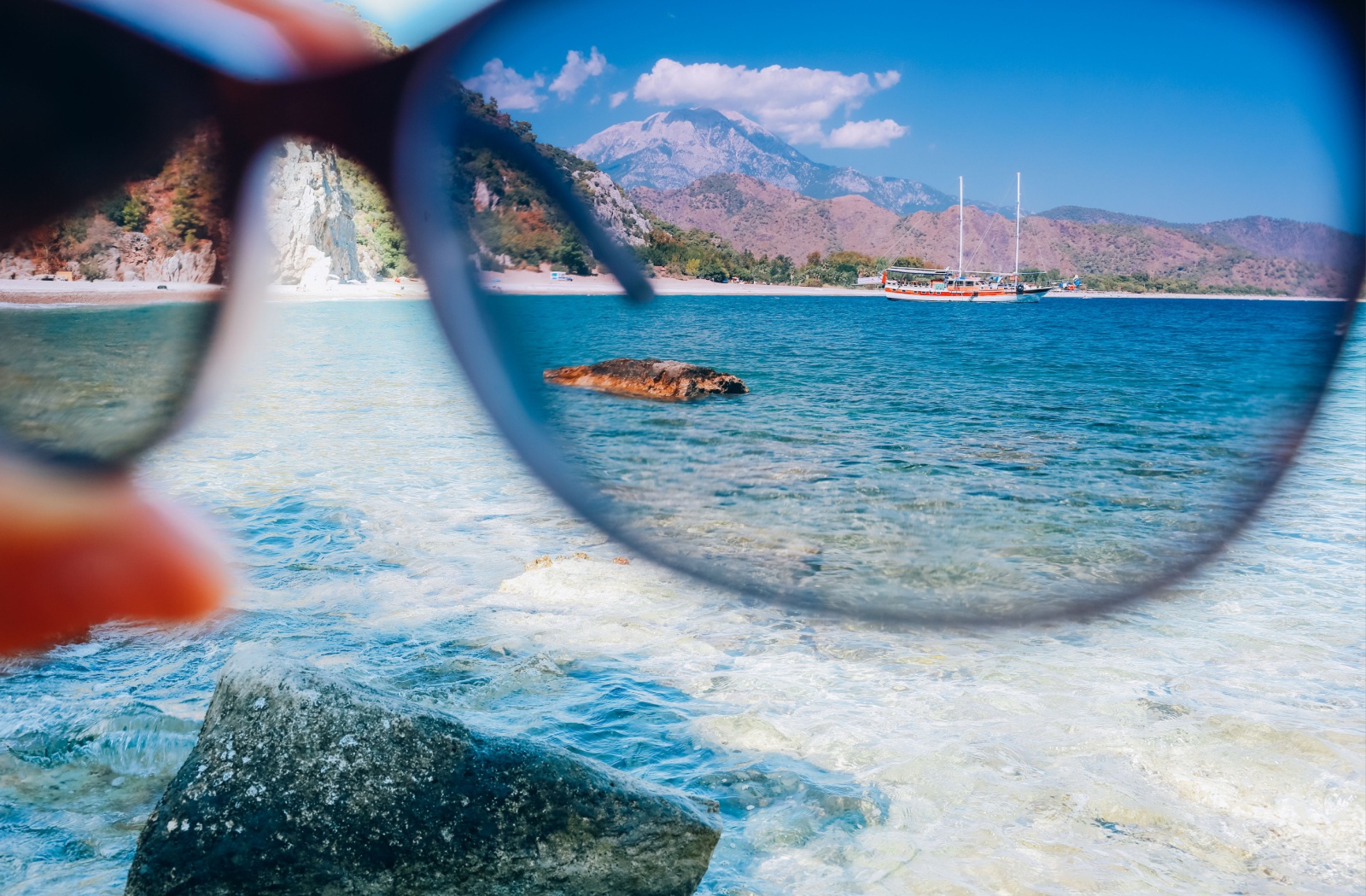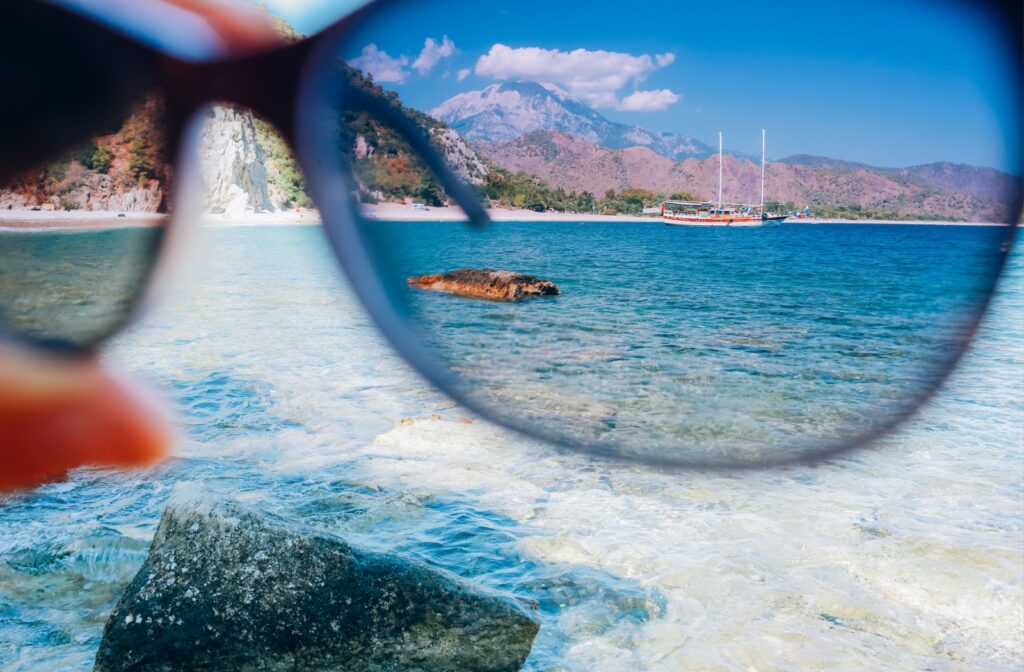Sunglasses are a simple finishing touch to any outfit, but investing in a quality pair is about more than looking good. A solid pair of sunglasses shields your eyes from the sun’s harmful rays while still allowing you to bask in its warmth (though make sure to remember your sunscreen).
Along with sun protection and reducing glare, polarized sunglasses enhance contrast and colors, making your surroundings darker and more vibrant.
Here are simple ways to test and see whether the lenses in your sunglasses are polarized:
- Screen test
- Reflection test
- Checking for polarized markings
- Comparing them to polarized lenses
Not all polarized sunglasses are equal. Fortunately, our expert team can help you find the perfect pair for your needs.
What Are Polarized Sunglasses
The power of sun protection lies in your lenses. Sunglasses technology is so much more than dark-tinted lenses (which don’t, by themselves, provide much benefit). Take polarized lenses, for instance.
Polarized sunglasses have a distinct chemical coating that reduces glare from light-reflecting surfaces like roads, water, snow, or glass. This glare can strain your eyes, making it difficult to see clearly.
The key distinction between polarized and non-polarized lenses lies in how they handle light.
Non-polarized sunglasses reduce the intensity of light entering your eyes, offering basic protection. However, with limited glare protection, this can make outdoor activities—like skiing, fishing, or even hiking—straining your eyes.
Polarized lenses go the extra mile. Their anti-glare filter blocks horizontal light waves (the primary cause of glare), offering greater visual clarity, comfort, and even enhancing contrast and colors.
Not only do they look stylish, but polarized lenses can support your outdoor performance!
How To Tell If Your Sunglasses Are Polarized
Sunglasses are more than just their tint and coatings, so a quick glance can’t always determine whether lenses are polarized. Side by side, a standard pair of lenses and ones with a polarized coating may look similar.
Luckily, some simple tests can confirm whether the sunglasses you’re wearing are polarized:
Screen Test
Polarized lenses are highly effective at blocking glare from electronic displays. Here’s how to test your sunglasses using your laptop or smartphone:
- Look at the screen through your sunglasses.
- Tilt your head 90 degrees to the left or right.
- If the lenses are polarized, you’ll notice the screen darken or slightly disappear as you rotate your head.
Reflection Test
Another easy way to test your sunglasses is by using a reflective surface like a car hood, window, or calm body of water:
- Put on your sunglasses and look at the reflected light.
- Tilt your head slowly to the side.
- If the glare diminishes or changes as you rotate your head, or if your vision darkens or lightens, your lenses are polarized.
Check for Markings
Some manufacturers go a step further, marking the lens or frame to indicate that they’re polarized. Look for labels such as “Polarized” or “P” engraved on the lenses or listed somewhere within the product details.
Compare with a Different Pair
If you know a friend has polarized sunglasses, it’s easy to compare your lenses with theirs.
Polarized lenses offer greater contrast and color enhancement, making them feel darker and your surroundings more vibrant than their standard counterparts. If you’re hanging out by the lake, for instance, you’ll notice a significant difference in how vibrant the water looks with polarized lenses as compared to regular sunglasses.
How UV-Protective Sunglasses Keep Your Eyes Safe
Polarized sunglasses do more than enhance your visual clarity. Similar to certain non-polarized sunglasses, they also shield your eyes from the sun’s harmful UV rays, which can damage your eyes over time.
We apply sunscreen to protect our skin from sun damage, similarly, sunglasses with UV protection (polarized or non-polarized) create a reflective barrier, blocking UVA and UVB rays that the earth’s atmosphere cannot absorb.
Prolonged exposure to UV rays can increase the risk of developing serious eye conditions which can affect your vision and overall eye health, such as:
- Corneal damage
- Cataracts
- Macular degeneration
- Growths on your eyes (cancerous and non-cancerous)
That said, not all sunglasses are created equal. Just because a lens has a dark tint does not mean it offers adequate sun protection. Instead, look for sunglasses (polarized or not) with a label of “100% UV protection” or “UV400,” which block or redirect UV rays for solid sun protection.
Where non-polarized sunglasses with UV-protection safeguard your eyes from sun damage, polarized sunglasses offer a two-fold advantage:
- They filter UVA and UVB rays to safeguard your eyes.
- They reduce glare, helping you see more clearly and avoiding visual distractions while driving or engaging in outdoor hobbies.
Proper sun protection is a must year-round, even when skies are gray and cloudy. Reflective surfaces like snow, water, or even shiny surfaces create glare. Snow in particular reflects up to 80% of UV rays, making polarized sunglasses invaluable for winter activities.
The Pros & Cons Of Polarized Sunglasses
Between polarized and non-polarized sunglasses, polarized sunglasses have the edge.
Although they’re a valuable investment for any outdoor enthusiast, you don’t have to be an avid outdoor lover to enjoy the benefits of polarized sunglasses.
Here’s a closer look at the advantages of polarized sunglasses:
- Enhanced visual comfort: Polarized lenses make your surroundings appear sharper and more defined by minimizing glare.
- Better eye protection: These lenses also filter harmful UV rays, offering an extra layer of defense against sun damage to your eyes.
- Reduced eye strain: Minimizing glare means your eyes won’t need to work as hard, making polarized sunglasses ideal for outdoor activities.
- Ideal for outdoor activities: Whether you’re driving, fishing, skiing, or hitting the beach, polarized lenses improve visibility and color perception to enhance your experience.
Here’s the thing: polarized lenses can make your vision appear darker. This is where the perks of polarized shades often fall short, for example:
- Operating heavy equipment, especially in low-light conditions when visibility is already reduced.
- Polarized lenses make it harder to notice patches of ice, putting your safety at risk when driving in poor weather conditions or participating in winter sports like snowboarding or skiing.
- Screens appear darker, making it harder to see your smartphone or computer.
Non-polarized sunglasses are a much better fit in these instances.
Protect Your Vision Today
Polarized sunglasses are more than a style statement; they’re also a powerful tool for protecting your vision and enhancing your outdoor experiences.
Whether you’re an outdoor lover or simply need sharper visibility during sunny days, investing in a reliable pair of polarized sunglasses is worth it.
If you’re in the market for quality shades, connect with our team at Dr. Jennifer L. Shane & Associates. We’re always happy to help you find that perfect pair of sunglasses.



